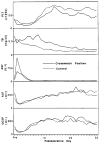A clinicopathological study of human liver allograft recipients harboring preformed IgG lymphocytotoxic antibodies
- PMID: 1505910
- PMCID: PMC2956418
- DOI: 10.1002/hep.1840160310
A clinicopathological study of human liver allograft recipients harboring preformed IgG lymphocytotoxic antibodies
Abstract
Twenty-six adult patients with preformed IgG donor lymphocytotoxic antibodies received primary liver allografts under FK 506 immunosuppression. The effect of the crossmatch-positive state on early graft function and on the immunopathological and histopathological findings was compared with that of 52 crossmatch-negative control recipients. The presensitized (crossmatch-positive) patients had prolongation of early graft dysfunction, underwent more clinically indicated biopsies and had a higher incidence of cellular rejection, both overall (p less than 0.05) and within 10 days of transplantation (p less than 0.01). They also had a higher incidence of graft failure in the first 180 days (p less than 0.01). Hyperacute rejection with necrotizing or neutrophilic arteritis was not seen in the crossmatch-positive grafts. However, histological findings associated with presensitization included platelet margination in central veins and sinusoids in biopsy specimens 60 to 90 min after graft revascularization. Later biopsy specimens had neutrophilic portal venulitis followed by cholangiolar proliferation, acute cholangiolitis and centrilobular hepatocyte swelling that mimicked preservation injury, endothelial activation of arteries with medial changes and relapsing episodes of acute cellular rejection. These clinicopathological observations suggest that lymphocytotoxic antibodies can have a deleterious effect on liver allograft function and survival, even if they do not precipitate immediate or hyperacute rejection.
Figures









Similar articles
-
A clinicopathologic study of isolated intestinal allografts with preformed IgG lymphocytotoxic antibodies.Hum Pathol. 2004 Nov;35(11):1332-9. doi: 10.1016/j.humpath.2004.07.001. Hum Pathol. 2004. PMID: 15668889
-
Liver allograft rejection in sensitized recipients. Observations in a clinically relevant small animal model.Am J Pathol. 1993 May;142(5):1383-91. Am J Pathol. 1993. PMID: 8494042 Free PMC article.
-
IgG donor-specific crossmatches are not associated with graft rejection or poor graft survival after liver transplantation. An assessment by cytotoxicity and flow cytometry.Transplantation. 1995 Nov 15;60(9):1016-23. Transplantation. 1995. PMID: 7491675
-
Antibody-mediated rejection in the liver allograft.Curr Opin Organ Transplant. 2012 Jun;17(3):280-6. doi: 10.1097/MOT.0b013e328353584c. Curr Opin Organ Transplant. 2012. PMID: 22569512 Review.
-
Liver transplantation with a strongly positive crossmatch: case study and literature review.Liver Transpl. 2013 Sep;19(9):1001-10. doi: 10.1002/lt.23694. Epub 2013 Aug 18. Liver Transpl. 2013. PMID: 23798324 Review.
Cited by
-
Role of splenectomy in human liver transplantation under modern-day immunosuppression.Dig Dis Sci. 1998 Sep;43(9):1931-7. doi: 10.1023/a:1018822206580. Dig Dis Sci. 1998. PMID: 9753254 Free PMC article.
-
Exploring pre-surgery donor-specific antibodies in the context of organ shortage in liver transplant.Langenbecks Arch Surg. 2019 Nov;404(7):865-874. doi: 10.1007/s00423-019-01831-9. Epub 2019 Nov 20. Langenbecks Arch Surg. 2019. PMID: 31748871
-
The liver allograft, chronic (ductopenic) rejection, and microchimerism: what can they teach us?Transplant Proc. 1995 Feb;27(1):67-70. Transplant Proc. 1995. PMID: 7879139 Free PMC article. Review. No abstract available.
-
Combined liver-kidney transplantation and the effect of preformed lymphocytotoxic antibodies.Transpl Immunol. 1994;2(1):61-7. doi: 10.1016/0966-3274(94)90080-9. Transpl Immunol. 1994. PMID: 8081794 Free PMC article.
-
The Future of Xenotransplantation.Ann Surg. 1992 Oct 1;216(4):3-10. Ann Surg. 1992. PMID: 25006273 Free PMC article. No abstract available.
References
-
- Starzl TE, Ishikawa M, Putnam CW, Porter KA, Picache R, Husberg BS, Halgrimson CG, et al. Progress in and deterrents to orthotopic liver transplantation, with special reference to survival, resistance to hyperacute rejection, and biliary duct reconstruction. Transplant Proc. 1974;6(4 suppl 10):129–139. - PMC - PubMed
Publication types
MeSH terms
Substances
Grants and funding
LinkOut - more resources
Full Text Sources
Other Literature Sources
Medical
